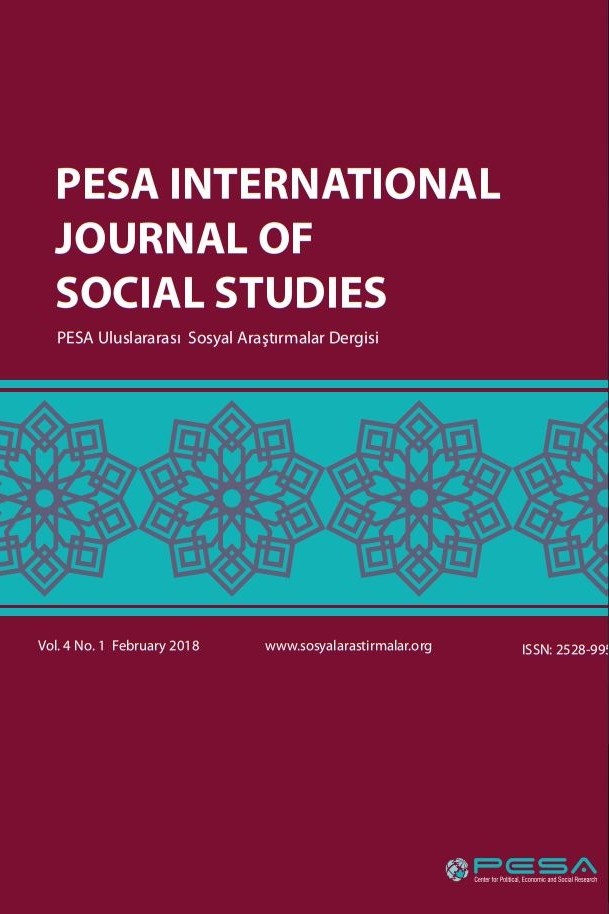LİDERLİK ÖZ-YETERLİĞİ ÖLÇEĞİNİN TÜRK KÜLTÜRÜNE UYARLANMASI: GEÇERLİK VE GÜVENİRLİK ÇALIŞMASI
Bu araştırmada Bobbio ve Manganelli (2009) tarafından geliştirilen Liderlik Öz-yeterliği Ölçeği’nin Türk Kültürüne uyarlanması amaçlanmıştır. Basit tesadüfi örnekleme yönteminin kullanıldığı araştırmada ölçeğin denemelik taslak formu 441 öğretmen adayına uygulanmıştır. Ölçeğin güvenirlik analizi, Cronbach’s Alpha iç tutarlılık katsayısı aracılığıyla tespit edilmiştir. Geçerlik analizi ise açımlayıcı ve doğrulayıcı faktör analizi ile saptanmıştır. Öncelikle liderlik öz-yeterliği ölçeğinin açımlayıcı faktör analizi sonucunda ölçeğin tek faktörlü bir yapı oluşturduğu ve ölçeğin açıkladığı toplam varyansın % 42.90 olduğu bulunmuştur. Doğrulayıcı faktör analizi sonuçları bu yapıyı doğrulamıştır (χ²= 388.39, sd= 150, RMSEA= .068, CFI= .97, IFI= .97, SRMR= .048, GFI= .89, AGFI= .86). Güvenirlik analizi sonuçlarına göre ise liderlik öz-yeterliği ölçeğinin Cronbach’s Alpha iç tutarlılık katsayısı .92 olarak saptanmıştır. Bununla birlikte madde güvenirlik analizlerinde ölçek toplam puanlarına göre oluşturulan alt %27 ve üst %27’lik grupların madde puanları arasındaki fark anlamlı bulunmuştur. Sonuç olarak liderlik öz-yeterliği ölçeği 6 faktörlü orijinal faktör yapısının Türk kültürüne uyarlanması sonucunda tek faktörlü yapı gösterdiği görülmüştür.
Anahtar Kelimeler:
Liderlik öz-yeterliği, Etkili liderlik, liderlik yetkinlik inancı
___
- KaynakçaAnderson, D. W., Krajewski, H. T., Goffin, R. D., & Jackson, D. N. (2008). A leadership self-efficacy taxonomy and its relation to effective leadership. The Leadership Quarterly, 19(5), 595-608.
- Bandura, A. (2006). Guide for constructing self-efficacy scales. Self-efficacy Beliefs of Adolescents, 5(1), 307-337.
- Bandura, A. (1997). Self-efficacy: The exercise of control. New York: Freeman.
- Bandura, A. (1986). The explanatory and predictive scope of self-efficacy theory. Journal of Social and Clinical Psychology, 4(3), 359-373.
- Bobbio, A., & Manganellii, A. M. (2009). Leadership self-efficacy scale: A new multidimensional instrument. TPM-Testing, Psychometrics, Methodology in Applied Psychology, 16(1), 3-24.
- Büyüköztürk, Ş. (2011). Sosyal bilimler için veri analizi el kitabı. Ankara: Pegem Akademi.
- Çokluk, Ö., Şekercioğlu, G., & Büyüköztürk, Ş. (2010). Sosyal bilimler için çok değişkenli istatistik: SPSS ve LISREL uygulamaları. Ankara: Pegem Akademi.
- Gist, M. E., & Mitchell, T. R. (1992). Self-efficacy: A theoretical analysis of its determinants and malleability. Academy of Management Review, 17(2), 183-211.
- Hannah, S. T., Avolio, B. J., Luthans, F., & Harms, P. D. (2008). Leadership efficacy: Review and future directions. The Leadership Quarterly, 19(6), 669-692.
- Hu, L. T., & Bentler, P. M. (1999). Cut off criteria for fit indexes in covariance structure analysis: Conventional criteria versus new alternatives. Structural Equation Modeling: A Multidisciplinary Journal, 6(1), 1-55.
- Kane, T. D., Zaccaro, S. J., Tremble Jr, T. R., & Masuda, A. D. (2002). An examination of the leader’s regulation of groups. Small Group Research, 33(1), 65-120.
- Kane, T. D., & Baltes, T. R. (1998). Efficacy assessment in complex social domains: Leadership efficacy in small task groups. Paper presented at the annual meeting of The Society of Industrial and Organizational Psychology. Dallas, TX.
- Leithwood, K., & Jantzi, D. (2008). Linking leadership to student learning: The contributions of leader efficacy. Educational Administration Quarterly, 44(4), 496-528.
- Luthans, F., & Peterson, S. J. (2002). Employee engagement and manager self-efficacy. Journal of Management Development, 21(5), 376-387.
- Machida, M., & Schaubroeck, J. (2011). The role of self-efficacy beliefs in leader development. Journal of Leadership & Organizational Studies, 18(4), 459-468.
- Maurer, T.J. (2001). Career-relevant learning and development, worker age, and beliefs about self-efficacy for development. Journal of Management, 27, 123-140.
- McCormick, M. J., Tanguma, J., & López-Forment, A. S. (2002). Extending self-efficacy theory to leadership: A review and empirical test. Journal of Leadership Education, 1(2), 34-49.
- McCormick, M. J. (2001). Self-efficacy and leadership effectiveness: Applying social cognitive theory to leadership. Journal of Leadership Studies, 8(1), 22-33.Ng, K. Y., Ang, S., & Chan, K. Y. (2008). Personality and leader effectiveness: a moderated mediation model of leadership self-efficacy, job demands, and job autonomy. Journal of Applied Psychology, 93(4), 733.
- Paglis, L. L. (2010). Leadership self-efficacy: Research findings and practical applications. Journal of Management Development, 29(9), 771-782.
- Paglis, L. & Green, S. (2002). Leadership self-efficacy and managers' motivation for leading change. Journal of Organizational Behavior, 23(2), 215-235. doi: 10.1002/job.137
- Prussia, G. E., Anderson, J. S., & Manz, C. C. (1998). Self-leadership and performance outcomes: The mediating influence of self-efficacy. Journal of Organizational Behavior,19(5), 523-538.
- Stajkovic, A. D., & Luthans, F. (1998). Social cognitive theory and self-efficacy: Goin beyond traditional motivational and behavioral approaches. Organizational Dynamics, 26(4), 62-74.
- Tavşancıl, E. (2002). Tutumların Ölçülmesi ve SPSS ile Veri Analizi. Ankara: Nobel Akademi.
- Zimmerman, B. J. (1995). Self-efficacy and educational development. Self-Efficacy in Changing Societies, 202–231. doi:10.1017/cbo9780511527692.009
- ISSN: 2528-9950
- Yayın Aralığı: Yılda 3 Sayı
- Başlangıç: 2015
- Yayıncı: Politik Ekonomik ve Sosyal Araştırmalar Merkezi
Sayıdaki Diğer Makaleler
Kasım Tevfik’in Palto Adlı Kısa Öyküsünde Toplumsal Gerçekçilik
Mehmet Şirin ÇIKAR, Murad KAFİ
LİDERLİK ÖZ-YETERLİĞİ ÖLÇEĞİNİN TÜRK KÜLTÜRÜNE UYARLANMASI: GEÇERLİK VE GÜVENİRLİK ÇALIŞMASI
Ramazan CANSOY, Mahmut POLATCAN
OKUMA KÜLTÜRÜ EDİNME SÜRECİNDE HANGİ KİTAPLARDAN NASIL YARARLANILMALIDIR?
ÜTOPYA VE DİSTOPYA’DAN SOSYAL GERÇEKLİĞE: CİNSİYETİN TÜKETİMİ
